Blog about successful marketing strategies in russia
Top Social Media & Live Streaming Platforms for PC Games in Russia

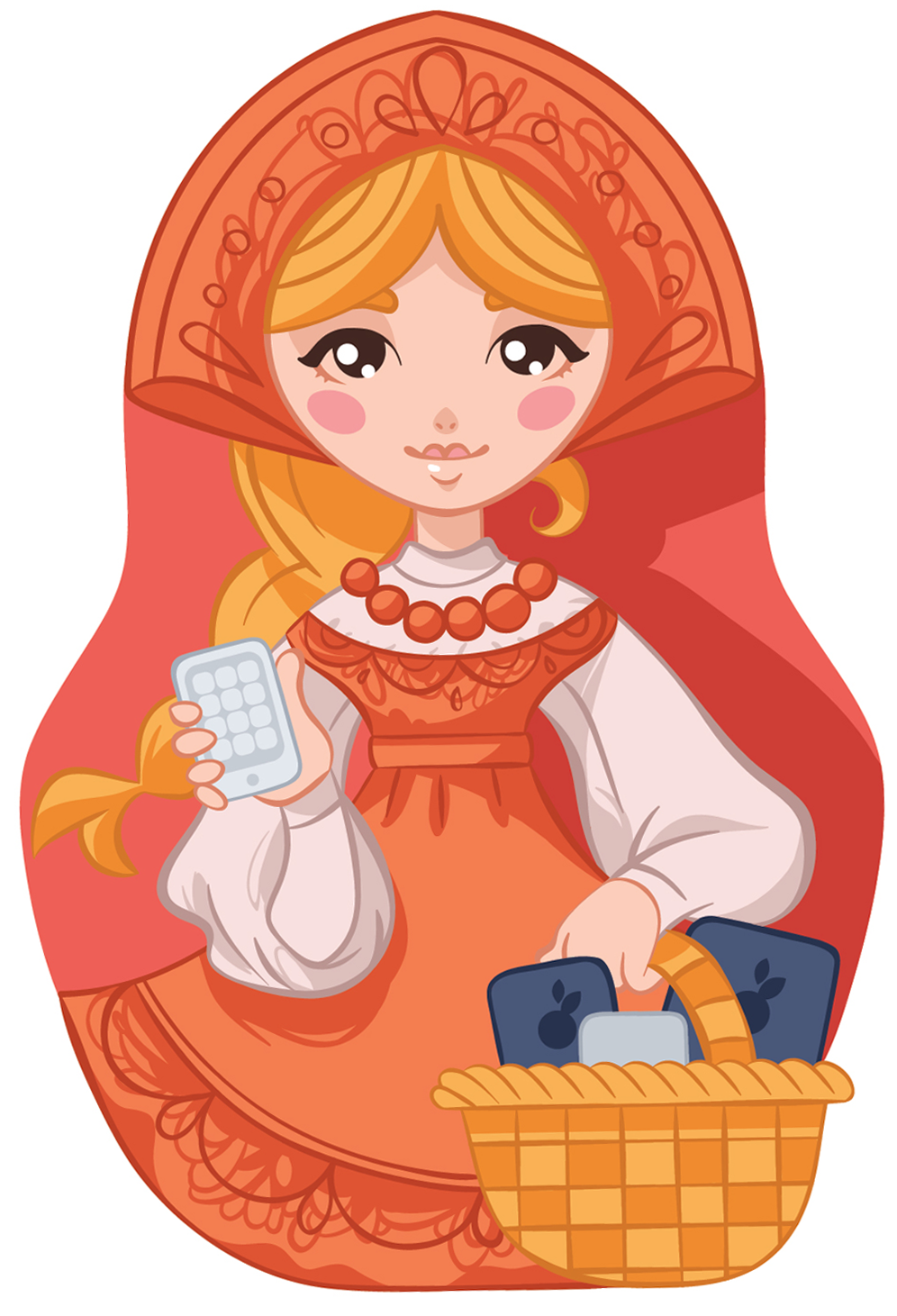
DIGITAL MARKETING
Share this Post
Great PC games are released almost every day. However, even the highest-quality title can go unnoticed without a well-targeted, localized marketing strategy — especially in Russia, where user behavior online differs significantly from Western trends.
As of 2025, there are 106 million active social media users in Russia. Most of them are men aged 18–34, consuming video content, memes, Let's Plays, and live streams on a daily basis. VK, Telegram, YouTube, Twitch, and Discord are the top five hubs for gamers. Interestingly, Telegram has now overtaken VK in terms of reach: 78.3% versus 67.7% of users.
Almost every gamer is active in at least one of these platforms. These are the spaces where you can drop announcements, build brand recognition, spark conversations, run giveaways, and efficiently scale audience engagement. This article offers a breakdown of the platforms and channels you can leverage to promote PC games in 2025.
Which social and streaming networks are used by gamers in Russia
In 2025, Telegram and VK are the two primary digital environments for gamers in Russia. Telegram reaches 78.3% of users, while VK covers 67.7%. YouTube continues to show strong engagement among men aged 18–34, the core demographic driving gamer traffic in the country.

Instagram and Facebook have lost their relevance for gaming brands. While a portion of the audience still accesses them via VPNs (around 20% of the population), reach is inconsistent, and results are too unpredictable to rely on.
Twitch continues to dominate the streaming space. In 2024, its Russian user base grew by 24%, and within a single month, over 590 paid placements ran on the platform, reaching a combined audience of 35 million viewers.
Discord remains the 'home base' for gaming communities. It's used for raids, tournaments, co-op development, discussions, and support. This is where you’ll find the most loyal and engaged users, making it one of the most promising channels for targeted community-driven promotion.
And then there’s Steam, still a core part of the gaming ecosystem. It serves as a hub for user communities, reviews, how-to posts, and trailers. While it’s not an ad platform in the traditional sense, it’s a strategically important touchpoint for PC game marketing.
Diversity of game promotional strategies in VK
The VK ecosystem includes over 30 digital products: a social network, video hosting, messenger, blog platforms, mini-apps, and its own ad service, VK Ads. Within it, there are ready-made tools tailored for game promotion, including ad formats specifically designed for gamer audiences.
A key component here is VK Play — the largest Russian platform for video game distribution and streaming. Over the past year, it has solidified its position as a central hub for gamers, developers, and streamers across Russia and the CIS. According to official stats, the platform now hosts more than 10 million registered users, 40,000 streamers, and over 10,000 games in its catalog.
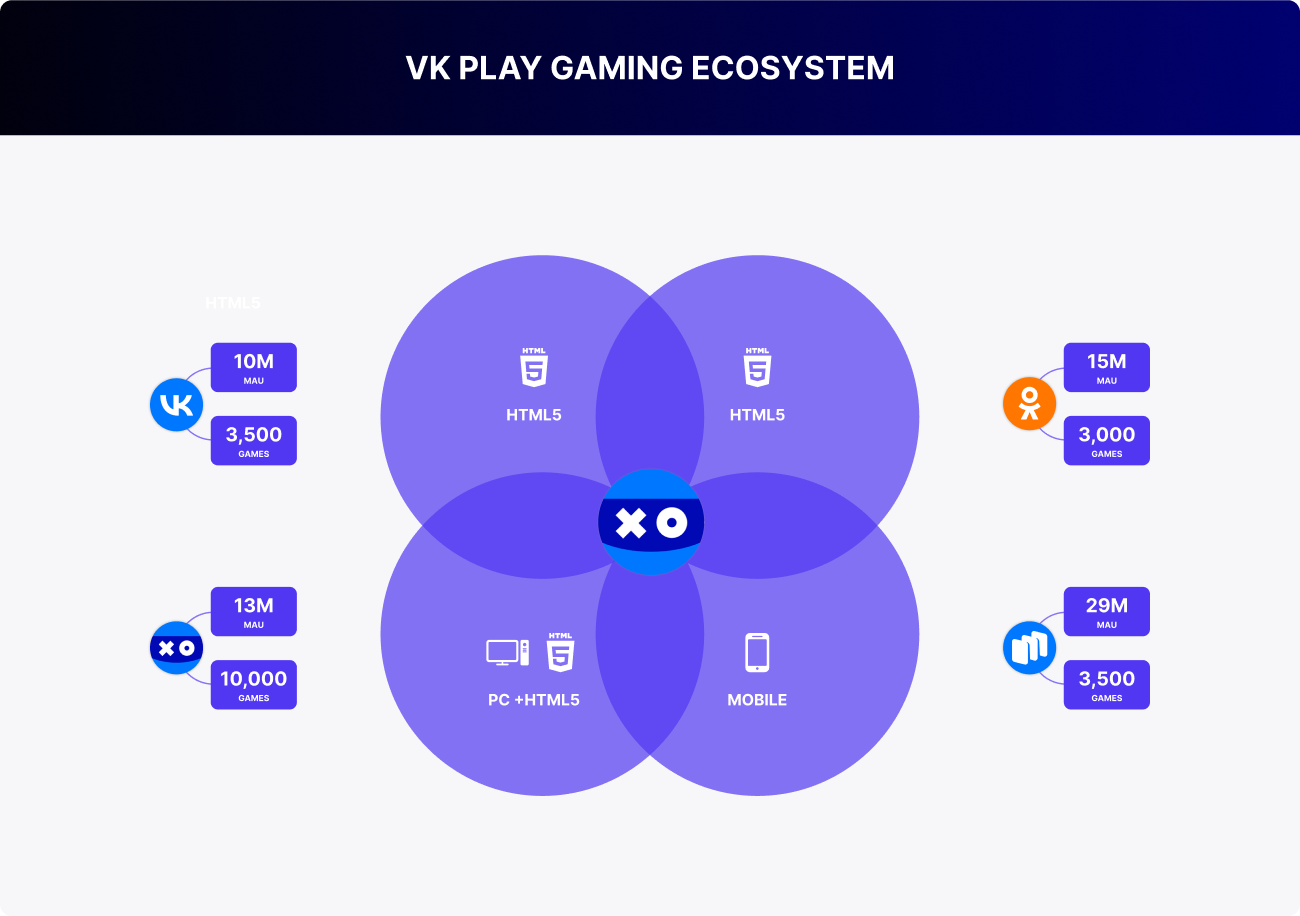
Inside it there’s its own streaming service with monetization options and creator support, VK Play Cloud for cloud gaming across devices, and an esports module featuring over 5,500 tournaments and built-in servers. There's also a news section with up-to-date reviews, and UGC communities with gamification and moderation features.
For game studios and brands, VK Play provides a full-scale promotional infrastructure: banner placements in the catalog, featuring in 'New' and 'Recommended' sections, free email campaigns to the user base, video ads, special projects, cross-ecosystem integrations within VK, and media partnerships.
You can take part in events, launch cashback-driven campaigns, and offer exclusive perks to your audience. All of this happens within one ecosystem — with built-in analytics, organic growth opportunities, monetization tools, and no need to rely on Western platforms.

Creating a VK game community
An official social media account is the official voice of the game. The most significant benefit of it is that it allows developers to engage with users on a more personalized level. This enables them to promote their game, provide updates, and solicit reviews and feedback from gamers.
Why is it better than a blog or website? Typically, gamers are not inclined to search for a website or read FAQs to find the answer to their question. Instead, they spend a significant amount of time on social media, where they engage with official game accounts. An official game account has become a familiar touchpoint: news, updates, and discounts appear directly in the feed. Interaction with the product is simpler, faster, and more natural, while engagement becomes deeper.
On VK, you can create a full-fledged community dedicated to a game, where the brand sets the tone and the rules for communication. This space serves multiple purposes: it's convenient for posting news, trailers, and updates directly in followers' feeds. It's also the place for giveaways, contests, and quizzes, using native, audience-friendly mechanics. Comments and polls allow for quick feedback, while users eagerly share UGC — screenshots, reviews, art, and cosplay.
Posts can be easily promoted through VK Ads, and collaborating with fan communities amplifies reach. Additionally, the platform offers moderation, advertising tools, and integration with VK Play. As a result, the community becomes a full-fledged media hub for the game. It can serve as a news channel, an announcement platform, a club for regular players, customer support chat, or even as a CRM tool through regular posts and active audience engagement.
Unlike a website, a VK community is a dynamic place where content comes to the user. This makes engagement higher and the path to the desired action shorter.
The Genshin Impact community on VK is a great example of how a foreign game brand can effectively integrate into a local platform and build an active community of over 1.4 million people from scratch.
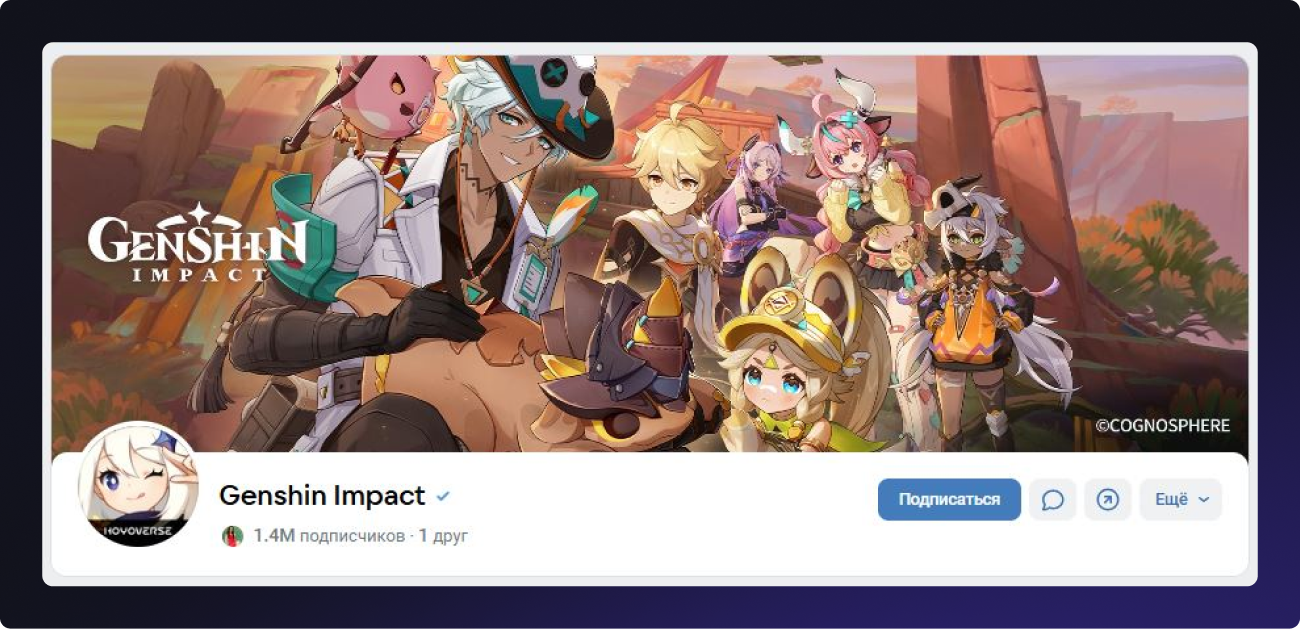
Official announcements, schedules, patch news, events, and banners are shared here — players learn about updates earlier than through aggregators. Guides and tips are regularly posted, not by developers, but by the players themselves — verified, localized, and moderated. User-generated content such as art, comics, and screenshots is actively promoted. The best works are featured on the platform, and the community itself becomes a showcase for talent.
Between major releases, memes and humorous content are posted to help maintain interest and keep the audience engaged. Comments, polls, and discussions turn the public page into a living space where people return not just for information, but for a sense of belonging.
The success of the community can be explained simply: it covers the entire user journey, from the first announcement to UGC and returning to the game. It takes on the functions of support and guidance, especially when the brand doesn’t have a local website or an official FAQ.
The community also serves as a platform for launching challenges, promotions, cashback, bonuses via VK Coin, and other activities. At the same time, it remains an independent communication channel with the Russian-speaking audience, without relying on Western platforms and with the flexibility to adapt the strategy to local conditions.
Paid Social in VK
The VK ecosystem offers its own advertising tool, VK Ads, which allows users to publish advertising banners, universal ads, and "carousels."
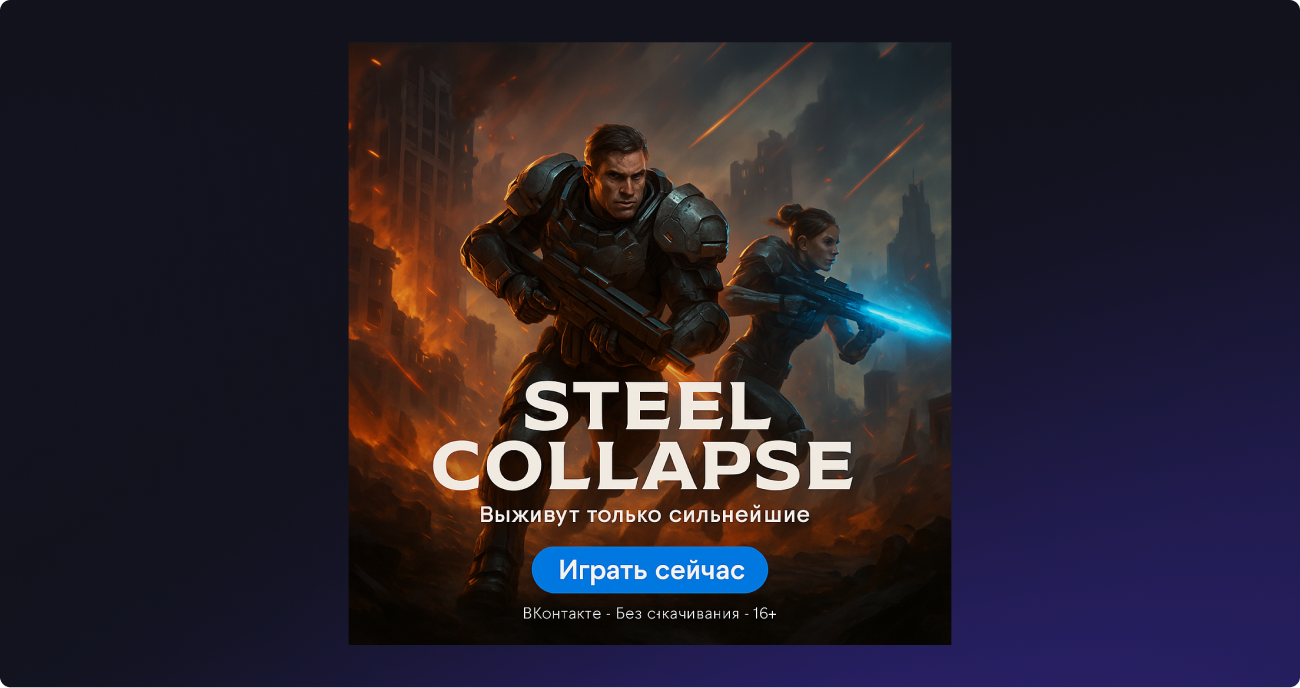
What makes VK Ads effective for game promotion:
- The platform offers ready-made strategies tailored for game development and mobile apps, which can be adapted for a game release, events, or beta testing.
- It allows targeting warm audiences from gaming communities: ads can be placed either through public pages or directly.
- Targeting is based on user behavior data: games they are subscribed to, apps they've installed, and where they spend the most time.
In practice, VK Ads typically serves as a tool for reach and brand awareness, especially when combined with UGC, giveaways, and community activities. Direct traffic for installations is generally enhanced through a multi-channel approach (VK Ads + Telegram + influencers). However, campaigns on VK alone still deliver strong results.
Average performance metrics:
- CTR (click-through rate) — about 0.87%, which is higher than most display ad formats in Russia.
- CPC (cost per click) — from 10 to 50 ₽ (roughly $0.11–$0.53), depending on the creative and competition level.
- Cost per subscriber to a game community — from 30 to 80 ₽ ($0.32–$0.84) with proper segmentation and setup.
With these metrics, VK Ads becomes a convenient and affordable way to enter the market. It’s used both for a quick start and in conjunction with higher-cost channels like Telegram, YouTube, or streaming platforms.
Advertising with opinion leaders and in VK communities
Inside VK, there are two effective models for native game promotion: through large gaming communities (public pages) and VK influencers — streamers, Let's Players, and meme creators.
Gaming public pages are large communities with tens of thousands or even hundreds of thousands of subscribers, where gamers read news, watch trailers, choose games from curated lists, and keep an eye on sales every day. Advertising in these groups helps showcase a game directly to the target audience in their familiar environment.
These communities are great for driving reach with visual and text formats, as well as for launching serial promo campaigns — from reviews and discount announcements to engagement-driven contests.
VK influencers are channel creators, streamers, and commentators with active, loyal audiences. Unlike faceless public pages, they present information personally through opinions, gameplay, and reviews.
This format tends to build more trust, especially in niche segments, and helps establish a closer connection with the audience: posts are commented on, discussed, saved, and shared with friends.
Opinion leaders who are not related to the game subject, but overlap with it in terms of target audience, are also involved in the promotion of video games in VK.
VK video about the Smuta game by Dmitry Goblin Puchkov
Video game communities on VK engage in the promotion of video games by posting advertisements in many formats, including contests, news, and fan posts.
For example, through UGC content based on strong emotions and recognizable imagery: fan videos, narrative cutscenes, montages with a nostalgic undertone. Formats where the audience recognizes iconic scenes and soundtracks from their favorite games work especially well. These videos spread quickly and are perceived as "own" content, even if they contain an advertising element.
A video posted in the group sparked active discussion and even criticism, but judging by the engagement, it drew significant attention to the game, even with the polarized opinions.
| Rank | VK Public | Subscribers |
|---|---|---|
| 1 | Games on VKontakte | 3.9M |
| 2 | IGM | 3.6M |
| 3 | Kuplinov Play | 2.7M |
| 4 | VK Play | 2M |
| 5 | Canobu | 152K |
| 6 | PlayGround.ru | 126K |
| 7 | App2Top | 5.9K |
According to open platform data:
- The reach of a single post in a gaming public page ranges from 70,000 to 250,000 views, depending on the theme.
The average CPE (cost per engagement) when working with micro-influencers is from 4 to 10 ₽, which is approximately $0.04–$0.11 per like, comment, or repost. - The most effective formats are “review + contest” and “series of posts + story.
Advertising with VK opinion leaders and public pages is particularly effective in the first 2 weeks after the game's release, during the beta launch period, and during seasonal sales (Steam, VK Play, etc.).
VK Messenger
VK Messenger is an integrated messenger within VKontakte, as well as a standalone product that allows users to create group chats based on shared interests, including gaming communities. These chats bring together dozens or even hundreds of people around a particular game, genre, or in-game event such as a raid, patch, or tournament.
Group chats serve as coordination hubs during online events, spaces for discussing game mechanics, bugs, and strategies, and most importantly, places where players feel like part of a community, gradually evolving into a loyal audience.
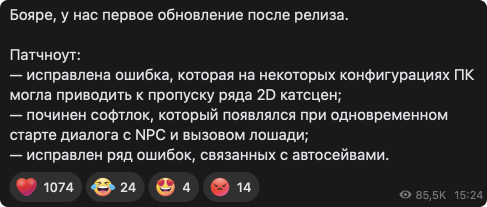
Message from the developers of the SMUTA game in the VK Messenger chat community
How do brands engage with gaming chats? Straightforward advertising won't be effective here, but there are other powerful approaches:
- bots with gamified mechanics like quizzes, giveaways, and progression-based games;
- recommendations from moderators and chat leaders as a more native format;
- partnership announcements timed with patches or events, when the community is most active.
VK Messenger offers a subtle way to influence the core of the gaming community. It's especially powerful after a game's release, helping to bring players back, keep them engaged, and build lasting trust in the brand.
Collaborations with YouTube gamers in Russia
YouTube remains one of the key channels for promoting games in Russia. Despite monetization being disabled and some speed restrictions in place, the platform is still accessible and actively used — many users simply watch videos through a VPN. Video content continues to enjoy strong popularity, with gaming ranking as the third most popular category on the platform. Even under current limitations, YouTube remains a highly effective tool for game promotion.
Due to difficulties with monetizing Russian channels, most advertising now comes to YouTube in the form of partnerships and collaborations between brands — both gaming and non-gaming. For example, Edison Perez shoots videos about Lego building in addition to gaming content, and EvgenBro uses the Squid Game setting for his Minecraft series.
Furthermore, marketing games on YouTube can involve a diverse range of channels beyond just those focused on gaming. To maximize audience reach during the Genshin Impact promotional campaign, for instance, RMAA employed unconventional strategies for YouTube advertising integrations.
Genshin Impact advertising integration on SlivkiShow channel by RMAA
Why does YouTube remain a relevant channel?
Gaming YouTube channels consistently rank among the top in the Russian segment by views and subscriber numbers. They boast high engagement and a broad yet thematically invested audience. You can check out the top Russian gaming creators of 2024 here.
YouTube’s biggest advantage is the long lifespan of its content. Videos continue to attract views even months after release — they're discovered through search, shared among users, and actively discussed in the comments.
On top of that, YouTube allows brands to build full-scale campaigns: from gradual audience warming and giveaways to embedding links and fostering real conversations with the community. The platform offers not just reach, but a chance to spark genuine discussions around a game.
Game promotion through YouTube in Russia still works, even without direct monetization and with access primarily through VPNs. The key is choosing the right content creator and integrating the ad naturally into their style. A particularly effective combo is video content, a contest, and a link to a VK or Telegram chat.
Native games advertising in Telegram channels
In 2025, Telegram is the most widely used messenger in Russia. According to DataReportal, 78.3% of Russians use the platform, and this number keeps growing. Telegram has long since outgrown its role as a simple messaging app. It has become a full-fledged platform for media, communities, and micro-influencers.
What does Telegram offer for game promotion?
- General gaming channels: they post news, trailers, compilations, discounts, memes, and polls.
- Genre-specific channels: there are dedicated spaces for horror games, shooters, Japanese RPGs, and more.
- Creator-driven channels: influencers, streamers, and Let's Players run their own Telegram feeds, sharing reviews, announcements, and links in a personal media format.
- Linked chats: for discussions, Q&A, commenting, user-generated content, and polls.
Full selection of current gaming Telegram channels
| Rank | Telegram Channel | Subscribers | Coverage of One Publication |
|---|---|---|---|
| 1 | Standoff 2 | 1.2 M | 689.1 K |
| 2 | Tanks Blitz | 513.2 K | 342.1 K |
| 3 | Mobile Legends: Bang Bang | 474.8 K | 92.3 K |
| 4 | Genshin Impact RU | 446.2 K | 157.5 K |
| 5 | GGSTANDOFF | 373.6 K | 35.8 K |
| 6 | Holdik Tele | 352 K | 351.7 K |
| 7 | Velya | 321.6 K | 77.2 K |
| 8 | Brat1shka | 297.5 K | 223.5 K |
| 9 | RAISE’S UNDERWEAR | 274.6 K | 70 K |
| 10 | PUBG MOBILE | 268.9 K | 27.7 K |
Direct ads like 'buy now' on Telegram almost always cause a negative reaction. The audience here expects a more native approach – personal, subtle, and in tune with the channel's style. The most effective formats are reviews with personal opinions, lists like 'what to play over the weekend,' giveaways inside chats, and links to demo or beta versions.
Besides, prominent Russian gamers maintain their author channels on Telegram. Their audience is large enough to consider the messenger as a platform for successful integration along with YouTube. Here they mirror YouTube videos, share their impressions, and discuss new products with subscribers right in the comments. Incidentally, their audience is large enough to consider the messenger as a platform for successful integration alongside YouTube.
| Rank | Telegram Channel | Subscribers, thousands |
|---|---|---|
| 1 | Edison Family | 959 K |
| 2 | Kuplinov Play | 938 K |
| 3 | Vlad Paper A4 | 692 K |
| 4 | Marmok_yt | 494 K |
| 5 | Maddyson | 144 K |
Streaming features on Twitch
While global interest in Twitch is gradually declining, the platform continues to gain momentum in Russia. In 2024, the number of Russian viewers grew by 24%, with the audience now ranging between 5 and 6 million people, roughly 3–4% of Twitch’s total user base, which exceeds 150 million active accounts. Russia firmly holds the second spot in traffic volume, trailing only behind the US.
In February 2025, Twitch recorded 1 billion visits worldwide — a 12.7% drop compared to January. The average session length was 8 minutes and 42 seconds, with a bounce rate of 28.7%. Despite this, the interest from the Russian audience remains steady.
Advertising activity on Twitch is also on the rise. In March 2024, brands ran 595 placements with 320 streamers, and by May, this number had increased to 842 placements across 364 streamers. Gaming leads the way (358 placements, a 25% increase from April), followed by betting companies (285 placements), but the sharpest growth can be seen in e-commerce (+76%), education (+47%), and finance, where the number of placements rose five and a half times.
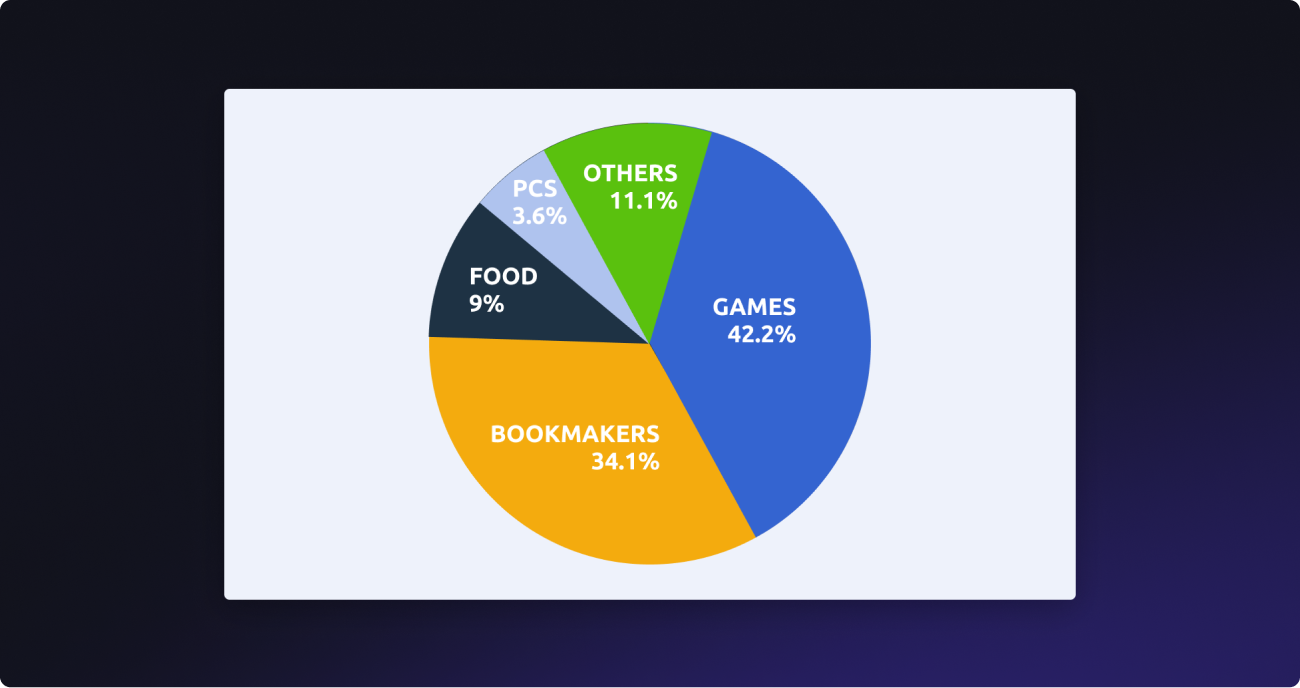
Twitch in Russia remains a platform where streams aren't just watched — they're discussed, shared, and eagerly anticipated. For brands, it's a place for real-time engagement with the audience, especially when using interactive strategies, from direct integrations to giveaways and launches during major events.
Affiliate ads on gamer pages
On Russian Twitch, gaming ads are more than just banners. Brands build entire narratives around the games. This often takes the form of sponsored streams tagged with #sponsored, where a streamer showcases a new release, shares their impressions, and interacts with the live chat. Broadcasts are enhanced with promo materials, channel designs styled to match the game, banners, and clickable links.
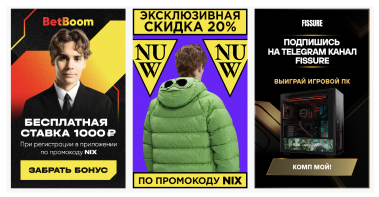
BetBoom, Nuw, Fissure ad integrations by gamer Nix on Twitch
According to the latest data (see chart above), gaming brands account for 42.2% of all ad placements on Russian Twitch, making it the most active category.
The platform offers a way to reach an audience that's hard to catch through traditional paid social, especially when a game is built around emotions, atmosphere, or blends multiple genres. Here, ads don’t interrupt the experience; they seamlessly blend into the stream, as if the streamer is simply sharing their thoughts with friends. This approach feels more like a recommendation from someone trusted.
Streaming delivers three key benefits at once: it showcases gameplay, explains the core of the game, and draws viewers into discussion. This is particularly valuable for complex mechanics, fresh releases, or remasters that demand extra attention and understanding.
When a game doesn't have a clearly defined target audience — like a new fantasy RPG — streaming integrations help reach a broader crowd and create the feeling of a live conversation, something a banner or a standard post simply can’t replicate.
Online streams
Streams have evolved into a full-fledged media platform. Viewers get information in real time, see the streamer’s genuine reactions, join giveaways and challenges, and feel like part of the action.
Thanks to this level of engagement, streams have long expanded beyond the gaming industry. They're now used to promote not just game titles, but also hardware like monitors and headsets, food and beverages, mobile subscriptions like VK Music and Kinopoisk, online courses, betting services, and even e-commerce products.
In the gaming segment, early previews of new releases, tournament streams with sponsor prizes, and live challenges — like ‘beat the game on hardcore and viewers win rewards’ — perform especially well.
Looking for the right streamer? Check out the latest ranking of the top Twitch channels in Russia.
| Rank | Game | Avg Twitch Channels | Avg Twitch Viewers |
|---|---|---|---|
| 1 | Fortnite | 6.9 K | 67.9 K |
| 2 | League of Legends | 2.2 K | 125.1 K |
| 3 | Grand Theft Auto V | 4.1 K | 178.6 K |
| 4 | Counter-Strike | 1.7 K | 69.3 K |
| 5 | Minecraft | 3.4 K | 41.6 K |
| 6 | Dead by Daylight | 1.7 K | 28.8 K |
| 7 | The Legend of Zelda: Breath of the Wild | 778 | 464 |
| 8 | Resident Evil 7: Biohazard | 27 | 260 |
| 9 | Super Mario Maker | 1.2 K | 3.5 K |
| 10 | Just Chatting (formerly IRL) | 20.5 K | 256.8 K |
Native post in the Twitch Stream chat
On Twitch, native formats embedded directly into the streamer’s behavior are increasingly replacing traditional banners. This approach feels natural, blends into the stream, and is perceived as part of the content.
Examples of native integrations:
- Chat posts during the stream — automated or manual messages featuring a promo description, a link to the game, or a special offer.
Example: ‘The new PvE shooter just dropped — check it out: (link)’. - Live giveaways — viewers get a chance to win in-game items, keys, donation packs, or merch. Mechanics based on chat commands like !join work best.
- Merch on camera — T-shirts, posters, branded headsets, or mugs placed naturally in the streamer’s studio. Visual contact like this strengthens brand recall and association.
Live giveaways are among the most effective formats. Viewers are offered in-game rewards, keys, donations, or merch, and participation happens right in the chat using simple commands like !join. This creates a sense of involvement and a real event, not just passive watching.
Merch on camera is equally powerful: T-shirts, posters, branded headphones, or mugs become part of the visual background, steadily building associations with the game. This format doesn’t require special attention. It quietly but effectively boosts brand recognition.
A crucial part of native advertising on Twitch is the streamer’s emotional reaction. When the streamer genuinely shows joy, surprise, or laughter, viewers pick up on it. They don’t trust a banner or a script — they trust the real person on the screen.
If a streamer enthusiastically mentions a product — even with just a few words like ‘Wow, this is awesome!’ or ‘Oh, I’ve been meaning to try this!’ — the audience sees it as a genuine recommendation, not a scripted ad.
These short emotional bursts work better than any traditional call-to-action: they don’t interrupt the flow of the stream, don’t require flashy links or effects, but they trigger trust and engagement.
Even simple integration into stream culture — through chat, visuals, or streamer reactions — drives engagement 1.5–2 times higher than a standard pre-roll ad.
The effectiveness of native ads during streams depends on a few key factors. Most important is the natural delivery — the viewer should never feel like something is being pushed. The streamer’s charisma and ability to maintain a connection with the chat are critical. It also matters how well the game matches the channel’s audience in spirit and genre. And, of course, gameplay itself plays a huge role: if the streamer knows the mechanics, plays confidently, and shows genuine interest, viewers are much more likely to trust what they’re seeing.
Streamers going on TV and offline
By 2025, Twitch in Russia had stopped being just an online platform. Streamers and influencers who started their careers there have become full-fledged media personalities: they appear on TV, host offline events, participate in shows, and sign advertising contracts outside of the digital space.
Thus, stream culture in Russia has completely transcended online formats. One of the key events was the first large-scale offline ceremony for gaming influencers – the SLAY Awards. It took place in Moscow and brought together top streamers, cosplayers, and partner brands. Twitch personalities received their own nominations, and sponsors included both gaming companies and representatives from the FMCG sector.
The largest streaming and video content festival in the CIS, Streamfest, has firmly established itself. It has become a magnet for both aspiring and well-known streamers, and most importantly, it has allowed their audiences to meet their idols in person. As a result, digital brands from Twitch, YouTube, VK Play, and other platforms have become part of the events industry, taking the stage and interacting directly with people.
The festival program includes everything: live performances by streaming stars from various platforms, themed discussions on monetization, platforms, copyright, and engagement, as well as evening concerts featuring streamer-musicians like TheBaldDrummer, BatmanGo, and RomanovaLera.
For brands, this is primarily an opportunity to go beyond the platform and connect with an already engaged audience. Top streamers are increasingly becoming part of multi-format campaigns: they’re invited to offline events, featured in collaborations for VK Video and YouTube, and shown on TV.
As a result, brands gain both reach and direct contact with audiences across different environments – from live broadcasts to exhibition halls. Streamers themselves turn into ambassadors, representing the product not only on streams but also on stage, in interviews, and on camera. This approach builds trust and creates more layered, comprehensive communication.
Why does Twitch deliver results?
The platform is especially popular with the 18-29 age group — the ones who spend their evenings playing CS2, Dota 2, Warzone, or PUBG. Streams are an effective way to spark interest in a game: launching early access, inviting influencers for joint sessions, and starting discussions in the chat.
If the product is complex or not immediately clear, the platform helps convey its essence through emotions and the streamer’s reactions. Their presentation replaces dry instructions: viewers literally feel how the product is played.
Twitch is often used in combination with Telegram and VK. This helps reach both the live segment and those who read, discuss, and share links after the broadcast.
Engagement tools in Discord
Discord remains one of the most flexible and immersive platforms for building gaming communities. Everything is tailored for gamers: voice and text chats, built-in events, cooperative tools, and easy navigation between channels. Over half of the active servers on the platform are dedicated to games — from PvP and MMO to modding, role-playing campaigns, and indie project testing.
In October 2024, access to Discord was officially blocked in Russia, but this didn’t stop users. The audience continues to actively access the platform through VPNs, mobile proxies, and alternative DNS. Fan communities for games like Genshin Impact, Atomic Heart, and Dota 2 are still thriving. Indie studios, as before, use the platform as a base for closed tests, gathering feedback, and working with their core players.
For gaming brands, it remains a valuable tool. Discord offers not just reach, but real engagement. It’s where discussions about mechanics and balance take place, along with quizzes and events, and the audience becomes part of the process, not just as viewers, but as part of the team. The platform offers flexible integration options: bots, branded emojis, paid roles, and access to private channels.
Unlike Telegram or VK, Discord is designed for long-term interaction. It works exceptionally well for retaining midcore and hardcore audiences, especially in games where immersion, player retention, and continuous community contact are key. Even under blocking conditions, the platform remains a hub of high engagement for those who are truly into the game.
Online tournament competitions
Tournaments and challenges on Discord are one of the most effective ways to promote PC games. The platform offers flexible tools for launching gaming events, from quick matches to competitive leagues. Everything is at hand: voice and video channels, schedules, automatic participant matching — all that’s left is to gather players and hit ‘start.’
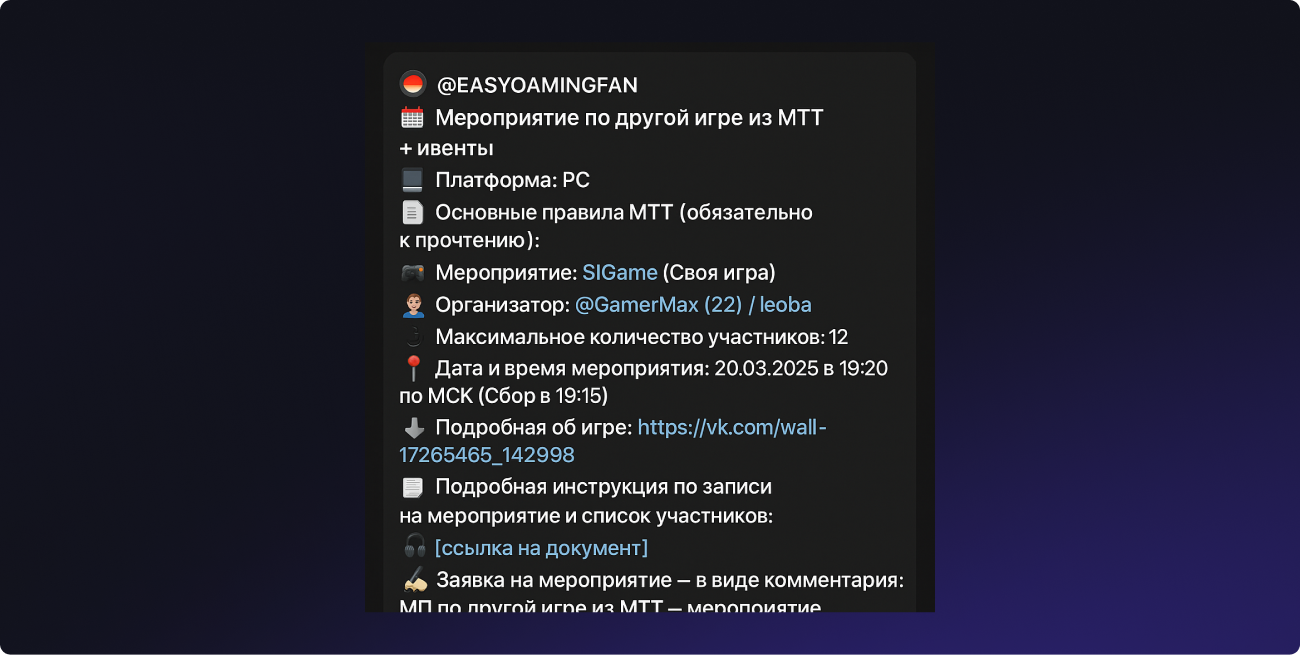
What can you organize directly on the server?
Online tournaments for specific disciplines — PvP, survival, or team tactics. Challenges like ‘complete it as fast as possible’ or ‘collect loot first.’ Competitions with your own rules that exist only within your community. And with event templates, everything can be launched in a couple of clicks: with voice rooms, schedules, and automatic pairing.
Communication between participants happens directly within the server — in text, voice, or video channels. This creates an atmosphere of engagement: players discuss matches in real-time, share screenshots, and fuel each other’s excitement. The server literally lives through the tournament.
Why does this work:
- The player doesn’t just watch, they participate, which means they get more deeply engaged and remember the game better.
- A tournament is a great excuse to remind players about the project and bring back old audiences.
- Promo codes, rewards, and prizes feel like part of the gameplay, not ads, making them more effective.
- One event can gather from 500 to 1000 participants, especially if influencers or large gaming communities are involved.
Cybersport tournaments are held in various disciplines, and there are special templates for their creation, which can be used to publish the event on the Discord server in a matter of minutes. Tournaments can be either solo or team-based, and communication between participants is facilitated through text, voice, and video modes.
Collaborations with gamers
A Discord server is a full-fledged platform where brands, influencers, and gamers can communicate directly, host events, and launch activities that work better than any advertisement. More and more developers and gaming companies are using the platform as a base for native promotions, contests, and loyalty programs.
What do brands and influencers do on servers?
They run giveaways and challenges, ranging from in-game items to branded merchandise.
For example, on the server of streamer Sirius and blogger Sasha Kapustin, branded merchandise was given away simply for participating in the event.
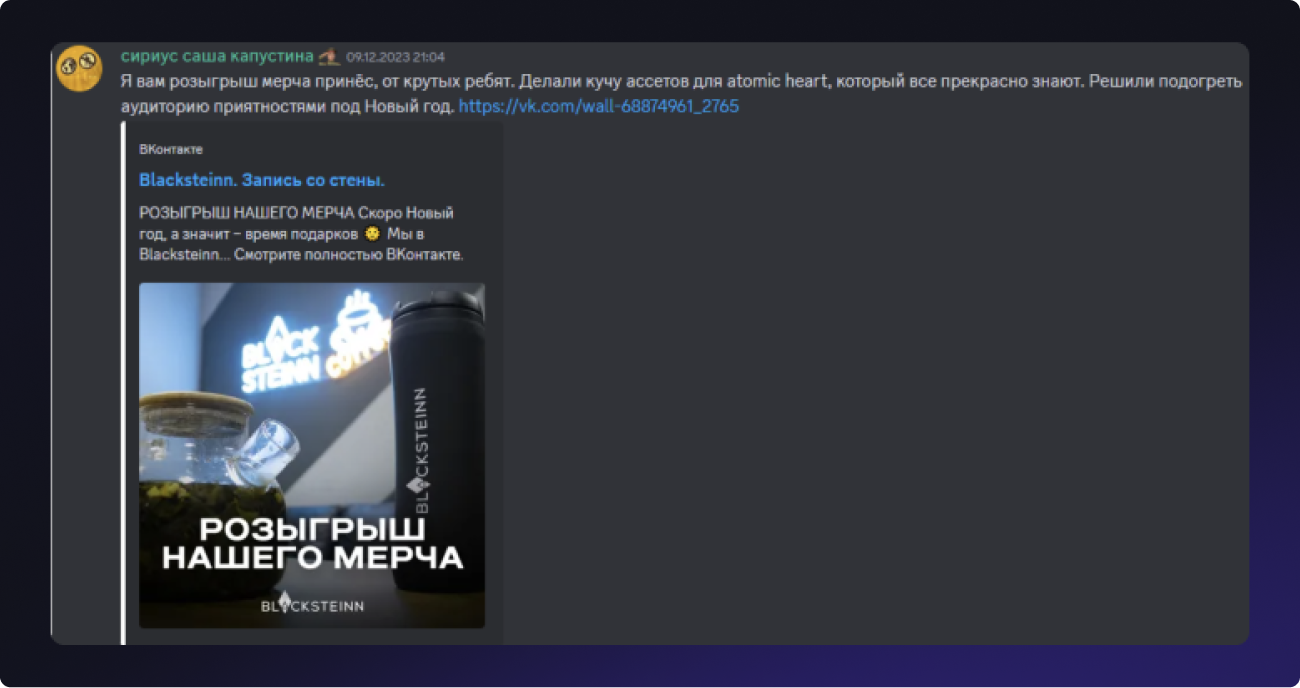
They host AMA sessions and live interviews in voice and video channels — users ask questions, and speakers respond without filters. This format brings them closer to the audience.
They also use the platform as an entry point into the community. For example, Marmok does this by including a link to his server in every video, where he shares behind-the-scenes content, interacts with fans, and announces events.
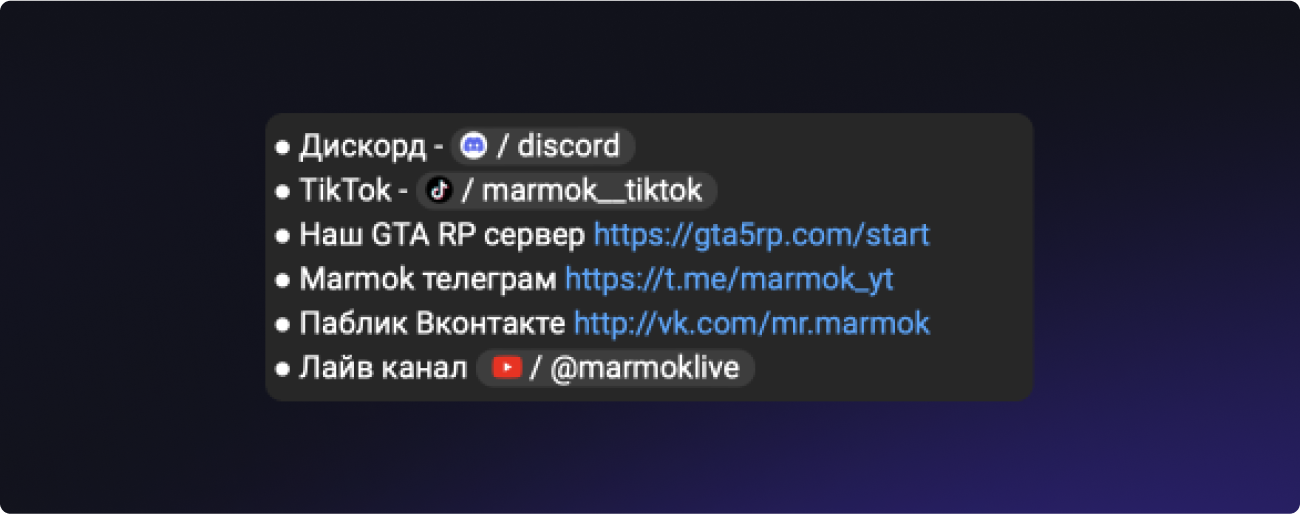
To facilitate communication with the gaming community, developers utilize chat rooms with moderators to announce games, updates, streams, and Q&As with the community.
Additionally, they integrate with Web3 platforms, where tokens, NFTs, and in-game activities are connected within a single system. In this case, Discord acts as a hub for the entire ecosystem.
How is it structured within the server?
- Text channels — for news, memes, discussions, and feedback.
- Voice rooms — for streams, tournaments, and real-time discussions.
- Video channels — for live broadcasts, exclusive presentations, and ‘play with us’ formats.
Developers often use dedicated channels for updates and important announcements as well as for surveys and early feedback. Moderators maintain order and help facilitate dialogue between the team and the players.
The list of active Discord servers for gamers, streamers, and brands is in the following table.
| Rank | Discord Server | Subscribers, thousands |
|---|---|---|
| 1 | Elysium | 264K |
| 2 | Futurama | 111K |
| 3 | Paradeevich | 49K |
| 4 | Sleep | 11.1K |
| 5 | Aletheia | 5.4K |
Discord is where real interaction happens between the brand and the players. Everything works through regular communication, informal activities, and collaborations with other platforms. People feel like they’re being genuinely spoken to here, not just being advertised to, which is why the platform is considered powerful for building loyalty.
Strategic conclusions
Social and streaming media in Russia are not just channels; they are separate ecosystems, each with its own format for engagement, user behavior patterns, and communication style.
Using all media is wise, but only if adapted to each platform:
- On VK, focus on community building, challenges, and VK Play.
- On Telegram, personal channels, UGC, reviews, and commenting are key.
- On Twitch, direct emotions, streams, and in-game reactions work best.
- On Discord, the strength lies in deep engagement and gaming mechanics.
- On YouTube, organic integration is crucial, not sponsor inserts without context.
What truly works in 2025? It’s a multi-channel approach with one strong idea that adapts flexibly to the unique features of each platform. Instead of chasing reach, the focus should be on micro-influencers and targeted efforts within niche gaming communities. Rather than dividing by gender and age, attention should shift to the behaviors and interests of the players themselves.
If you’re planning to launch a game in the Russian market, RMAA can help you develop a strategy tailored to each platform, test hypotheses, and achieve recognition without unnecessary costs.
Check out our case studies — they detail how we work with gaming audiences and promote projects across various platforms. And if you want to stay up to date on fresh trends and solutions, follow our blog. We regularly publish analytics and actionable insights.
*Meta Platforms Inc. projects, the activities of which are banned in Russia.
Join 2,000+
of your Peers!
You will be the first to know about Russian marketing insights, news and updates from our agency. Stay tuned!
Get our latest articles delivered to your email inbox and get our exclusive White Paper
"Digital Marketing in Russia. Finding your customers on the internet"
for FREE!
Video Games Promotion in the Russian Market
How to market games to Russian-speaking gaming community
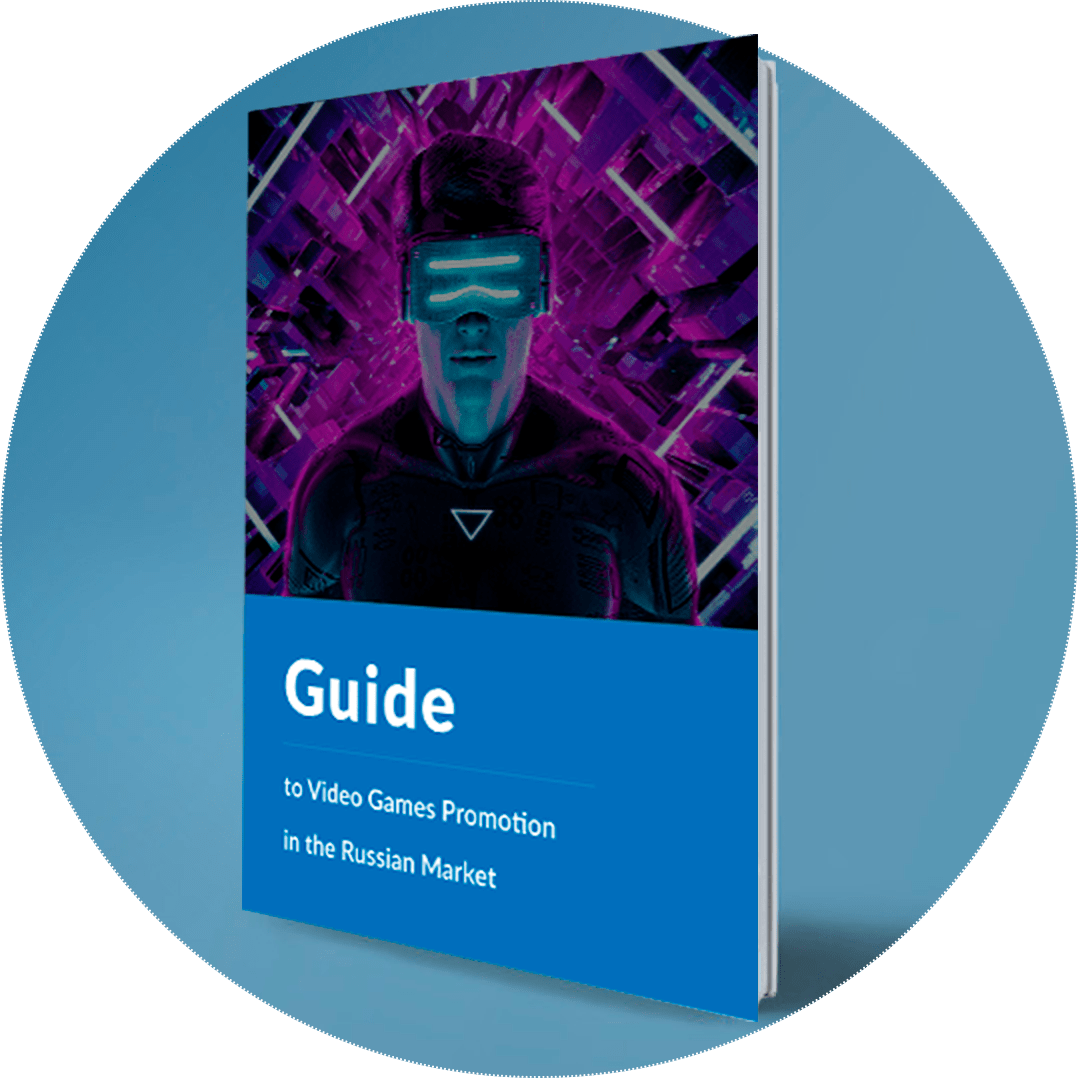
Ready to partner with the specialists in Russian marketing and advertising?
About the Author
Digital Strategist. Head of one of the project groups at RMAA. Maria started her journey in digital marketing in 2009.
Join 2,000+ of your Peers!
Get our latest articles delivered to your email inbox and get our exclusive White Paper "Digital Marketing in Russia. Finding your customers on the internet" for FREE!
You will be the first to know about Russian marketing insights,
news and updates from our agency.
Stay tuned!
We're updating our website's design step by step, so some pages may look different. Thank you for your understanding.
Got it














